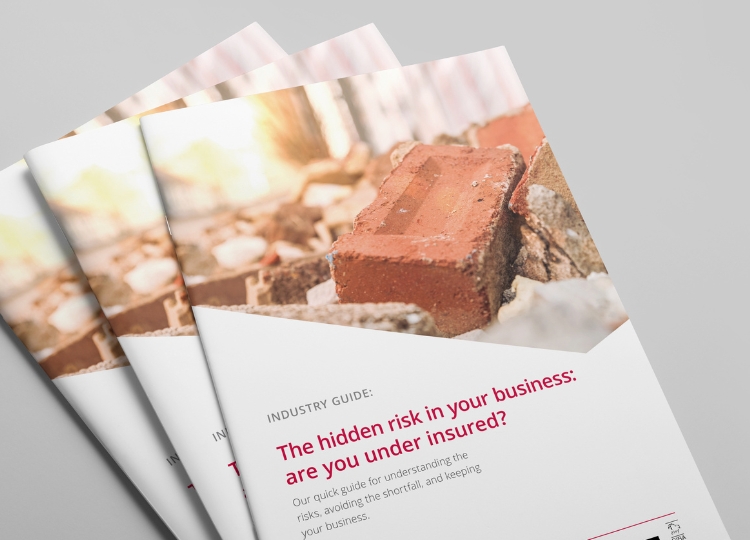Picture this – the worst happens. A minor electrical fault triggers a fire in the corner of your warehouse. Although the emergency services arrive quickly and the fire is contained, the damage is extensive. Smoke ruins large areas of the facility, leaving it inoperative whilst repairs are carried out.
Thankfully, you have insurance, with the warehouse insured for £1 million. The claim for clean-up and repairs totals £500,000.The bad news? The true reinstatement value of the warehouse building is actually £2 million, meaning your warehouse is 50% underinsured and that the maximum payout under your policy could be only £250,000. This leaves your business left to fund the remaining £250,000, a disaster when disruption is already hitting hard.
The story above is fictional, but it reflects a situation that could easily happen across the removals industry. According to Allianz’s 2025 report Avoiding Underinsurance in Construction, around 80% of the 4.3 million SMEs in the UK are underinsured. This is especially concerning for removal companies, who rely heavily on their operational buildings. An oversight in the accurate valuation of your warehouse building could derail your operations, your cash flow, and ultimately your reputation.
Understanding Underinsurance
Underinsurance is a silent threat to business continuity. It often only comes to light when you need insurance the most. Put simply, underinsurance means something is insured for a sum that falls below its true value. In other words, it has been covered for less money than it would cost to properly rebuild or replace. Common reasons for underinsurance include:
- Failing to arrange a proper buildings valuation recently
- Making building improvements but not updating your policy to reflect these in the sum insured
- Insuring based on market value rather than the actual cost to rebuild.
Commercial property policies include what is called an ‘average clause’. If your property is underinsured, the insurer reduces the claim payout by the same percentage by which you are underinsured. The principle being that by insuring on a lower sum insured you have not paid the correct premium so why should the insurers other policyholders subsidise your claim?
Example: Your warehouse should be insured for £2million, but it is only insured for £1 million. You are 50% underinsured. As a result, the insurer would only pay a maximum of 50% of any claim, no matter how small it is. This applies to both full and partial losses, meaning even completely valid claims can still leave businesses seriously out of pocket.
The hidden risk of small incidents
Because the average clause is applied to claims of any size, underinsurance is not just a problem when disaster strikes – it can also add expense to run-of-the-mill claims for small damages.
Imagine a smaller, everyday accident. One of your drivers reverses your vehicle into the warehouse cracking the brickwork and damaging the loading bay entrance. The repair quote comes back at £20,000, which you expect your insurer to cover. But remember your warehouse is underinsured for half its true value so applying the average clause: £20,000 × 50% = £10,000 payout which leaves a £10,000 shortfall for you to fund personally.
This was not a flood or a fire, just a small accident, yet it could hit your cash flow at the worst possible time.
Why removal companies are especially at risk
The reasons so many SMEs end up underinsured are numerous and dangerously easy to overlook, and for removal companies, the risks are even greater. Warehouses are dynamic spaces. Businesses adapt, expand, and upgrade their facilities over time, often without realising the impact on their insurance cover. A removals firm could be investing in themselves, unaware that their investment is making it more vulnerable to a loss at a time when, as a result of capital outlay in their business and premises, there is less liquidity in the firms’ funds.
It is common to see businesses working from outdated building valuations based on a construction cost estimation which is obsolete due to changes in material pricing. Since 2020, UK construction material prices have risen by around 20%, driven by COVID-19 supply chain disruption and skilled labour shortages. In 2021 alone, material prices surged by 24.5%, according to the Royal Institution of Chartered Surveyors (RICS).
When you combine these rising costs with undeclared improvements such as a new roof/guttering, mezzanine flooring for additional storage or updated security protection systems, a serious coverage gap can quietly build up. In an industry where tight margins and operational trust matter, that gap can quickly become the difference between survival and serious financial strain.
The good news is that underinsurance is preventable. Here are some practical steps you can take today to better protect your business tomorrow:
• Book a professional rebuild valuation. This valuation will also include an allowance for professional fees such as architects’ costs and debris removal/site clearance expenses. If your last valuation was more than three years ago, arrange a fresh assessment. If your building is leased and insured by your landlord, ask your landlord when they last had the building valued. After all it is in both your interests to ensure that the building is properly insured.
• Keep a log of all property improvements. Update your insurer regularly throughout the policy cycle, not just at renewal.
• Assess your business interruption cover. Make sure it reflects the real time it would take your business to fully recover from a major incident.
Small actions you take today can make a big difference in the future.
Quick check: are you underinsured?
- Have you had a professional rebuild valuation within the last three years?
- Have you made any improvements and not updated your policy?
- Is your insurance based on market value instead of the full rebuild cost?
If you’ve answered Yes to any of these questions, now is the time to review your cover.
Warehouses are not just buildings. They are the heart of your business, the foundation of your service and the trust your customers place in you. Insurance is there to rebuild what matters, but only if it is accurate and sums insured kept up to date can you rely on the policy to do this. A simple review today could help protect the future you have worked so hard to build.




